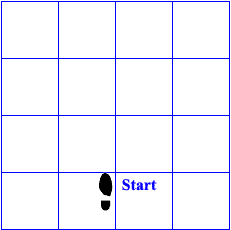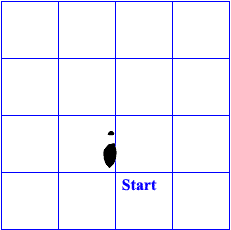
Email : [email protected] Or General Mailer
 |
Jai Chavan's
"Dance-Sport" Email : [email protected] Or General Mailer |
| Back || Master Pg. || Overview || Contents || Alphabetical Index || Home || Next |
Waltz: Basic Sequence: Part 6
| The first basic sequence. |
| Basic Sequence: | |
| 1. First Part 2. Second Part 3. Third Part 4. Fourth Part |
Reverse/Natural
Turn Hesitation Combination Under Arm Turn |
Sixth Lesson: Turns
Stand with feet together and on the spot turn at 45 degrees to
one’s left. Then again, turn similarly. Thus, four such
turns will make one turn a complete 180 degrees. Similarly turn
Right four time to come back to the original starting position.
It is very important to keep the feet together and perpendicular to the shoulder line. Also, keep looking at the wall in front to get the idea of how it appears on every turn with respect to you. This is essential since in a dance the walls give one the exact co-ordinates for the turns and to fixing one’s position on the dance floor.
Ballroom dancing is very simple, however it looks very elegant is mainly due to the discipline maintained. Thus, one should strictly adhere to the angles when turning.
Now we add these turns into the Fourth Part. For this all movements are as given above, however it has an additional component, the turn, which is between the forward/backward step and the next side step. Thus move forward for "1" as usual, then on the same foot turn, then move to the side for "2". Similarly for backward movement, move backward, then turn on the same foot, and then move to the side.
Thus for the first twelve counts all the turns would be to the left when commenced with the Left foot forward, and then for the next twelve counts it would be to the right.
The important part to note is that the turn is to the left if the Left foot moves forward or the Right foot moves backwards. Similarly the turn is to the right if the Right foot moves forward, or the Left foot moves backwards.
Note: Any turn to one’s left is termed as the ‘Reverse Turn’. Thus, generally the name of a figure that has turning to the left starts with "Reverse". Similarly for right turns it is "Natural".
| 1. Reverse Turn: Man | |
 |
Forward Half (Man) 1. Move forward first, then turn on the ball of the Left foot. 2. Right foot to the side with respect one’s self in the new position. 3. Left foot closes in to the Right foot. Backward Half
(Man) |
| 2. Reverse Turn: Lady | |
 |
Backward Half (Lady) 1. Move straight to backwards first, then turn on the heel of the Right foot. 2. Left foot to the side with respect to one’s self in the new position. 3. Right foot closes in to the Left foot. Forward Half
(Lady) |
Please Note:
Forward Turn: This is when one has moved forward prior to
turning. Thus, there is a wide gap between the first and the
second step.
Backward Turn: This is when one has moved backward prior to
turning. Thus, the gap between the first and the second step is
negligible.
Alternative Pattern 1
Start the exercise with the Left foot moving back for the count
‘1’ and forward for the count ‘4’. Thus, the
turns would be to one’s right for the first twelve counts.
After which the turns would be to the Left for the next twelve
counts.
Now you could practise with a partner. Once you are confident with it, begin doing all the four parts sequentially and adding the component of turn whenever one is doing the Regular.
| Back || Master Pg. || Overview || Contents || Alphabetical Index || Home || Next |